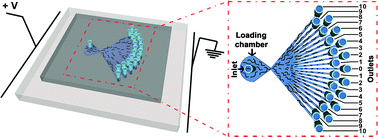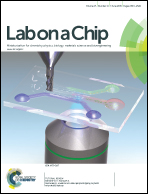Highly efficient microfluidic sorting device for synchronizing developmental stages of C. elegans based on deflecting electrotaxis†
Abstract
C. elegans as a powerful model organism has been widely used in fundamental biological studies. Many of these studies frequently need a large number of different stage-synchronized worms due to the stage-specific features of C. elegans among 4 distinct larval stages and the adult stage. In this work, we present an interesting and cost-effective microfluidic approach to realize simultaneous sorting of C. elegans of different developmental stages by deflecting electrotaxis. The microfluidic device was fabricated using PDMS consisting of symmetric sorting channels with specific angles, which was further hybridized to an agarose plate. While applying an electric field, different stages of C. elegans would crawl to the negative pore with different angles due to their deflecting electrotaxis. Thus, the worms were separated and synchronized by stages. lon-2 mutant was further used to study this electrotactic response and the results indicated that the body size plays a key role in determining the deflecting angle in matured adult worms. In addition to discriminating wild-type hermaphrodites, it could also be employed to sort mutants with abnormal development sizes and males. Therefore, our device provided a versatile and highly efficient platform for sorting C. elegans to meet the requirement of large numbers of different stage-synchronized worms. It can also be further used to investigate the neuronal basis of deflecting electrotaxis in worms.


 Please wait while we load your content...
Please wait while we load your content...